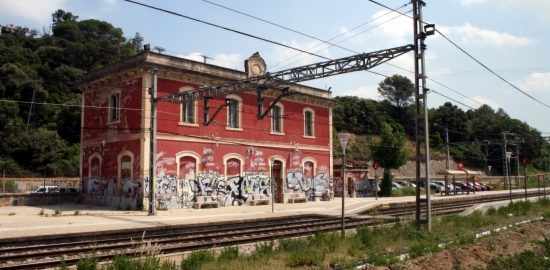SPAIN AGAINST THE CATALONIA NATION -- Spain’s investment in Catalan transport infrastructure falls to lowest level in 20 years | VilaWeb
Spain’s investment in Catalan transport infrastructure falls to lowest level in 20 years
Last year Catalonia received 9.9% of the Spanish Government budget
for transport infrastructure, despite Catalan GDP accounting for 18.9%
of the total GDP of the state
2015 was the worst year regarding Spain’s investment in transport
infrastructures in Catalonia since the historical data series began in
1997. According to a study published this Thursday by Barcelona’s
Chamber of Commerce, last year Catalonia received 9.9% of the Spanish
Government budget for transport infrastructure, despite Catalan GDP
accounting for 18.9% of the total GDP of the state. Furthermore, the
president of the Camber, Miquel Valls, denounced that only 59% of the
budget was executed, in comparison to the average for all the regions of
the State, which stood at 72%. According to this study, the 2015 budget
for Catalonia totalled €949.5 million, but only 555.9 million worth of
investment was executed.
‘The findings are not new, but yes are quite worrying, because never
before has such a low state investment in infrastructure in Catalonia
been registered. Catalonia, not only has less budget that it should
according to its GDP, but also the level of execution is lower than the
average of the autonomous communities overall. The state is prioritising
infrastructure such as the AVE in Galicia, aside from more productive
investments such as the Mediterranean corridor, which has experienced a
delay in development’, Valls argued.
In this vein, the president of the Chamber claimed that public
investment in infrastructure should grow at the rate of GDP in order not
to ‘impede’ economic growth. ‘Currently, the lack of state investment
is an obstacle for the Catalan economy and companies operating in the
country’, said Valls.
Renfe, one of the flagships of underinvestment in Catalonia
One of the flagships of underinvestment in Catalonia in terms of
transportation infrastructures is Renfe. The public Spanish train
operator has seen numerous incidences during the past decade, including
entire collapses of the high-speed, medium and short distance services.
In December 2009, the Spanish Government transferred the management of
secondary parts of the service such as cleaning, corporate image and
time schedules to the Catalan Government. However it did not transfer
the railway infrastructure, the stations, the electric systems or the
trains. Therefore, the main part of the service was still directly
managed by Spanish Government-owned companies, Adif and Renfe.
Indeed, Adif’s lack of investment in the short and medium distance
railway network in Catalonia has been recently taken before the Court by
the Catalan Government. The executive presented last Friday an appeal
before Spain’s High Court, the ‘Audiencia Nacional’, accusing the
Spanish public body in charge of railway infrastructure and the Spanish
Ministry for Infrastructure of failing to fulfil the agreed investment
plan. The project established a 306 million euros investment between
2014 and 2016, of which only 4.2% has so far been carried out. The
Catalan Minister for Territory and Sustainability, Josep Rull insisted
on the Government’s will to guarantee the ‘reliability’ of the network,
since it is estimated that in the last 4 years, more than 1,500
incidents on the railway service have been reported.
Andalusia, Castile and Leon and Galicia, regions with highest investment
According to the President of the Chamber, Miquel Valls, Andalusia,
Castile and Leon and Galicia are the autonomous communities being better
treated in infrastructure investment in relation to their contribution
to the economy. On the other hand, the most abused are Catalonia, Madrid
and Valencia, with the difference being that the implementation in
Catalonia is much lower than initially budgeted, while in the case of
Madrid investment executed exceeds the budget.
When asked whether the decline in investment in infrastructure has to
do with the political situation, Valls stated: ‘Relations between the
Government of Catalonia and the central government are not the best. Had
this an impact on public investment? Here are the details…’, pointing
to the study.
The report of the Chamber of Commerce also states that the lack of
state investment in infrastructure in Catalonia, understood as the
difference between actual investment and that which would correspond to
their economic weight, ‘has not only been reduced in the last year, but
has expanded significantly’. Thus, if the amount of state investment
implemented in Catalonia remained between the 16% and 18% recorded
between 2004 and 2010, this percentage fell from 2011 onward, and stood
at 9.9% in 2015.
Economic growth forecast
Barcelona’s Chamber of Commerce presented this Thursday, and revised
upwards, the growth forecasts for 2016, up to the 3.3%, due to the
positive figures in employment and rising domestic consumption.
According to Valls, the global slowdown and political instability have
had ‘null’ effect on the Catalan economy, which continues to grow stably
‘thanks to the entrepreneurial spirit of the entrepreneurship, which
increases investment and exports’, the president highlighted.
Exports to the EU rose by 3.8% between January and August, in
comparison to the same period last year. However, the Chamber warned
that it has begun to notice the effects of Brexit and the depreciation
of the pound, as Catalan exports to the United Kingdom have fallen by
5%. Although the economy continues to grow, Valls made clear that ‘risks
have not disappeared, only been postponed’. For 2017 a slight slowdown
is expected, but lower than that first predicted, and the year may
close with a growth of 2.7%.

